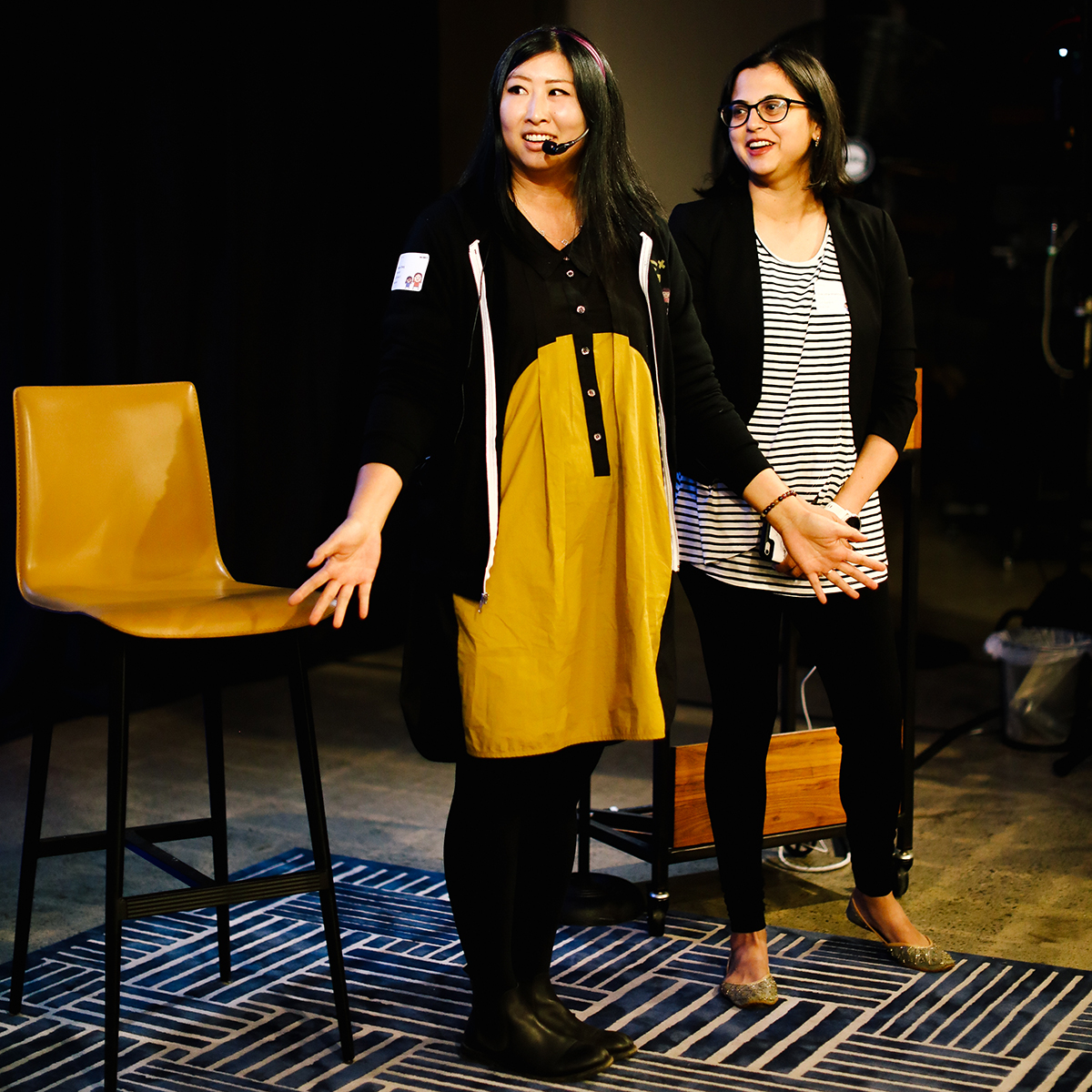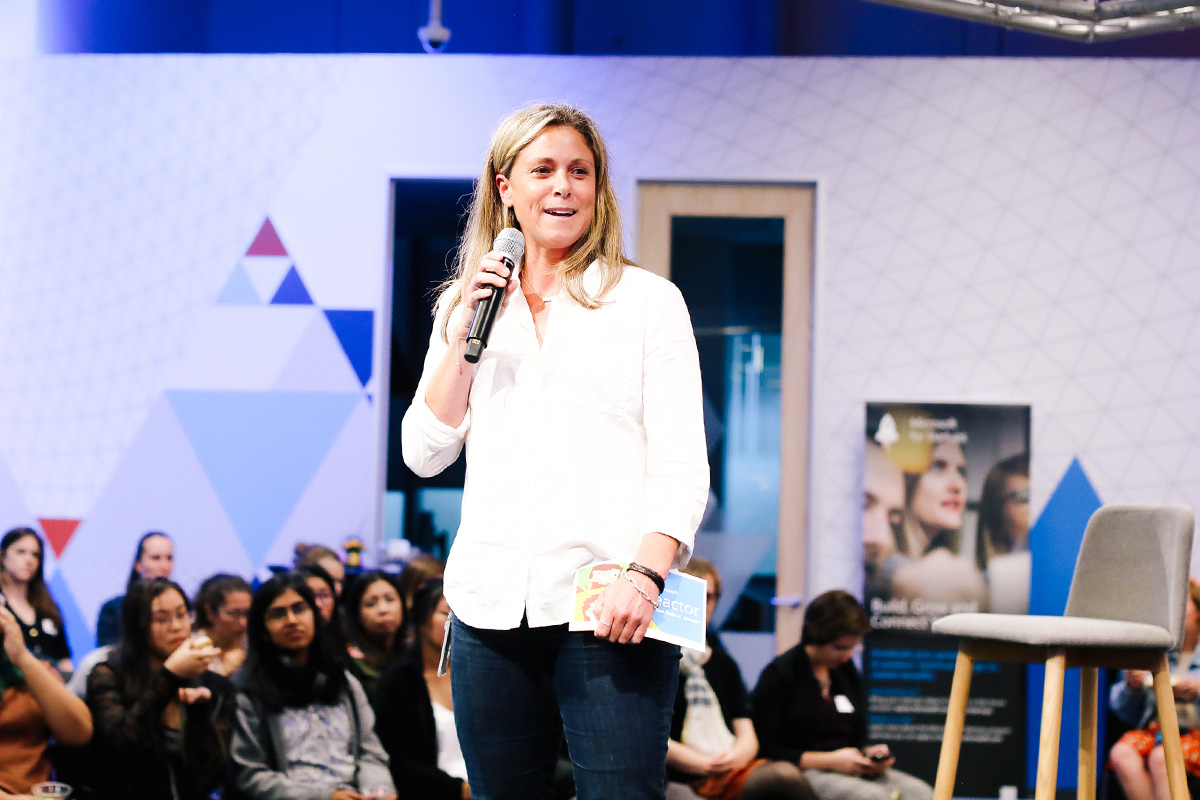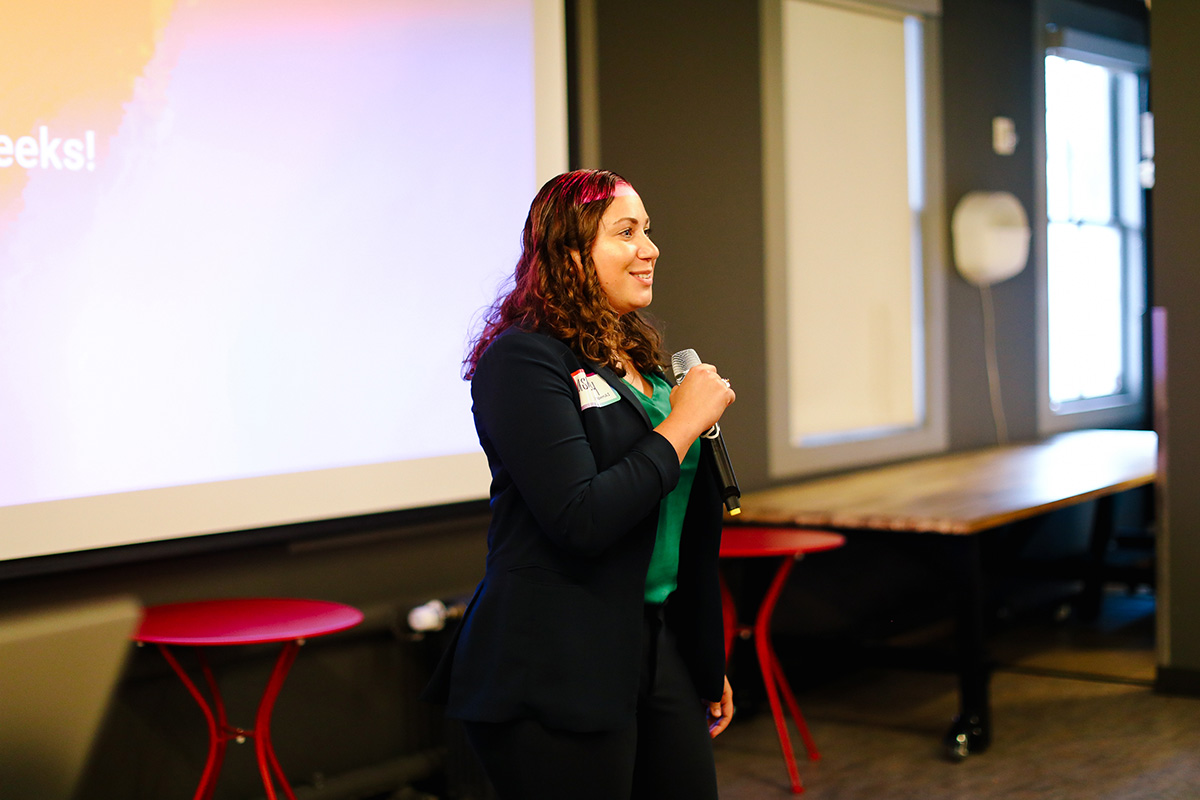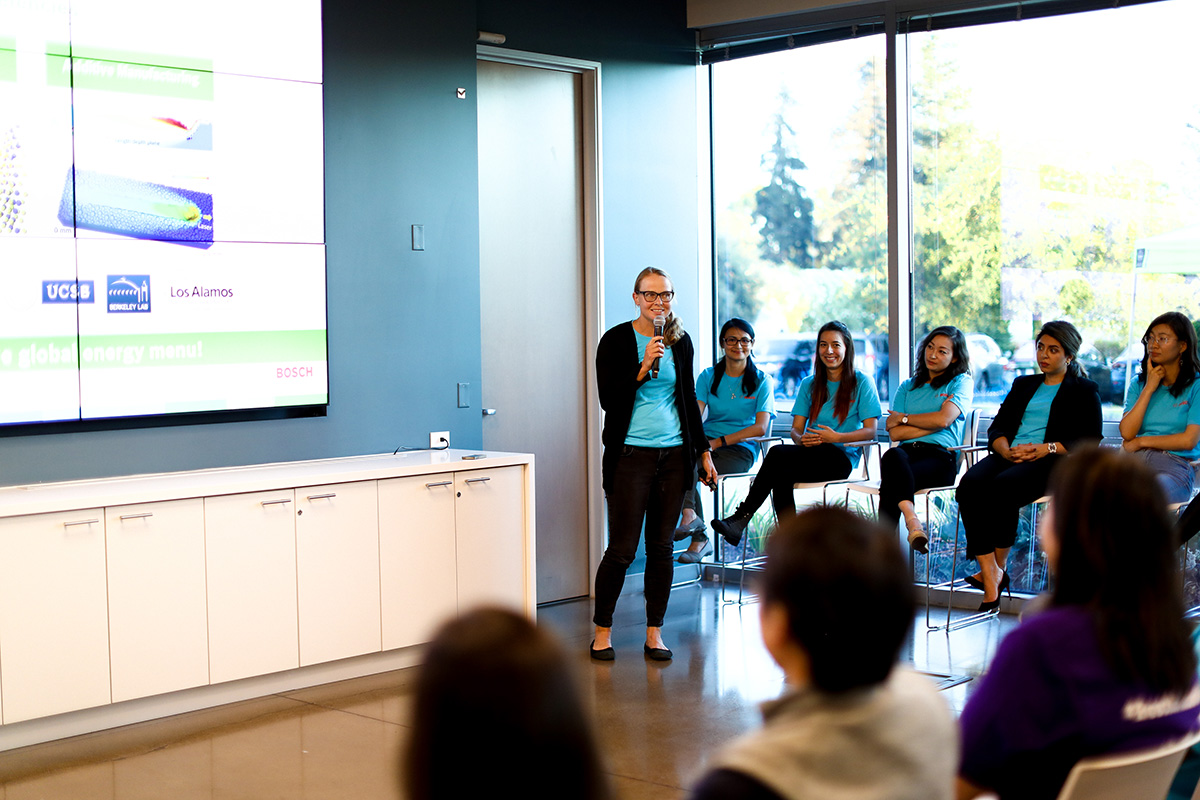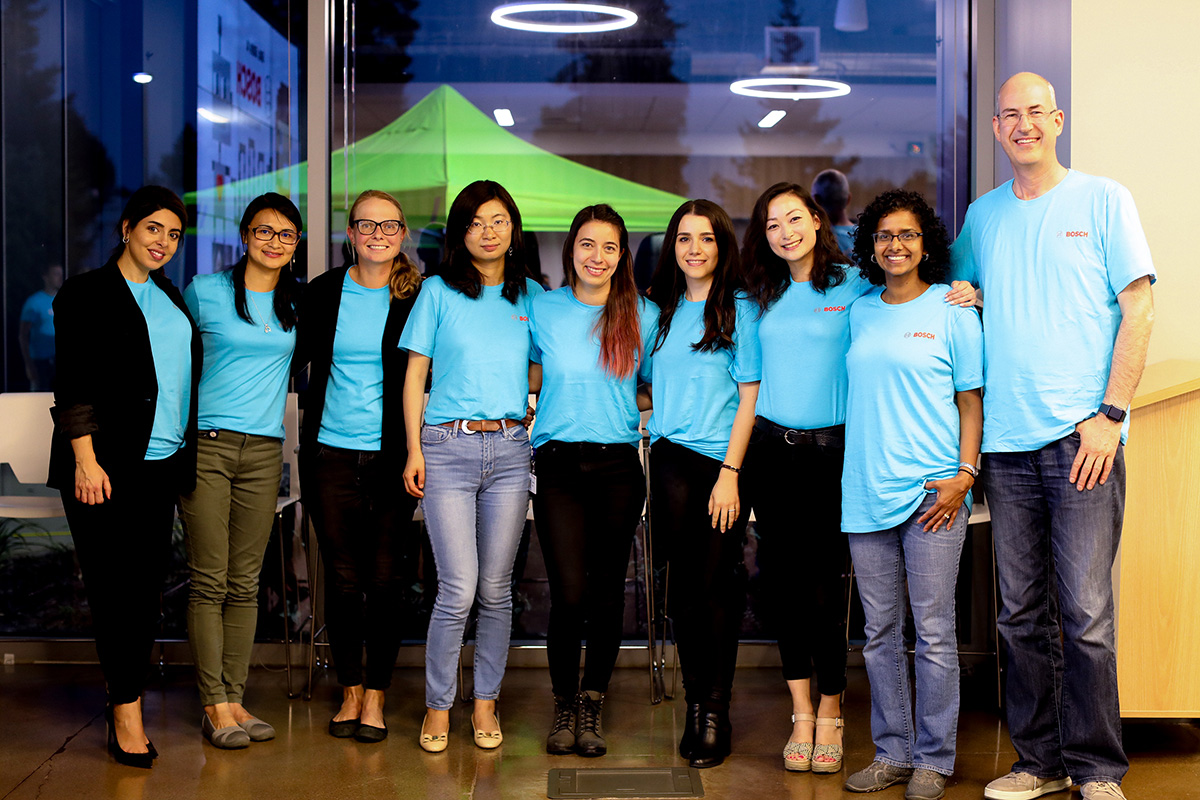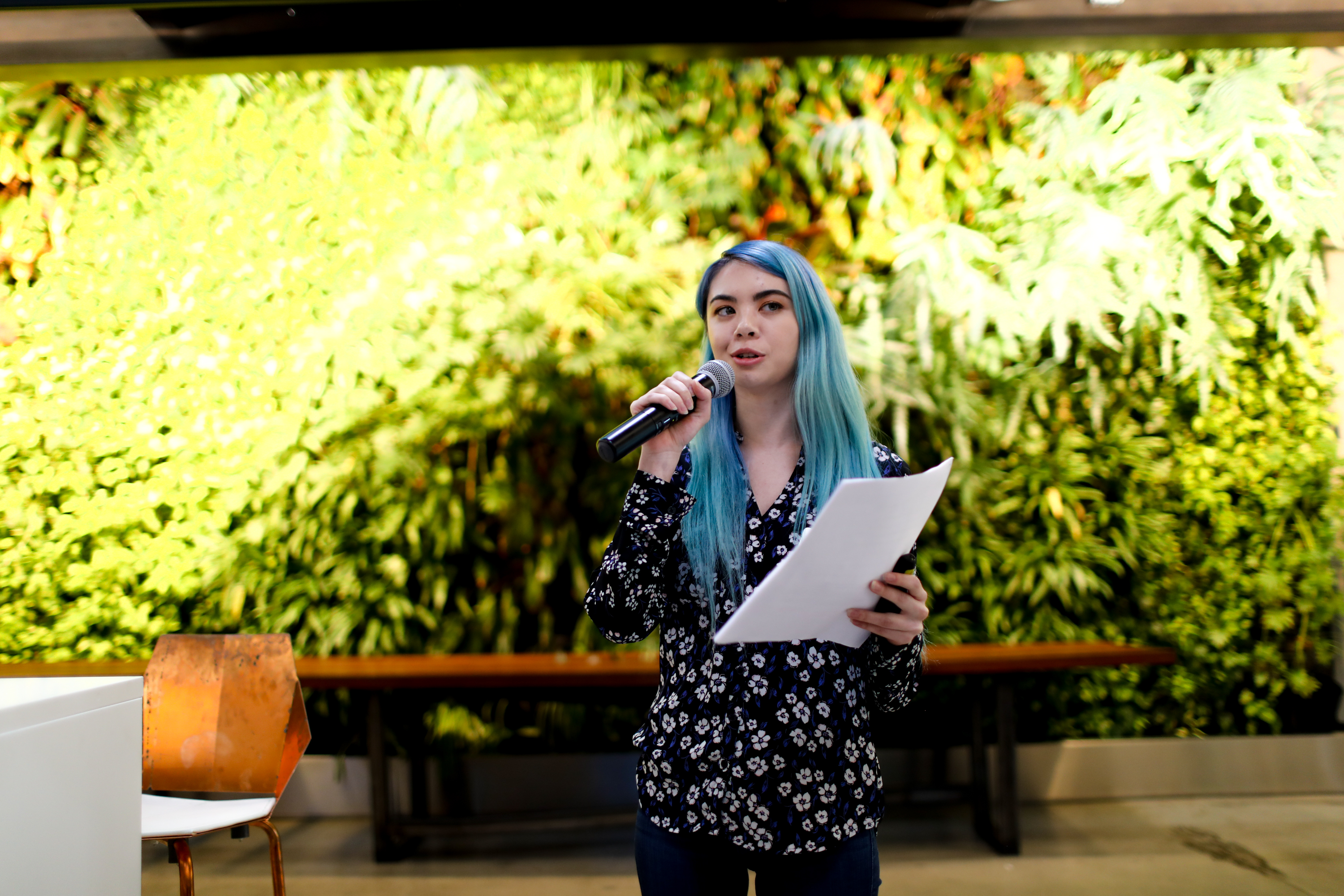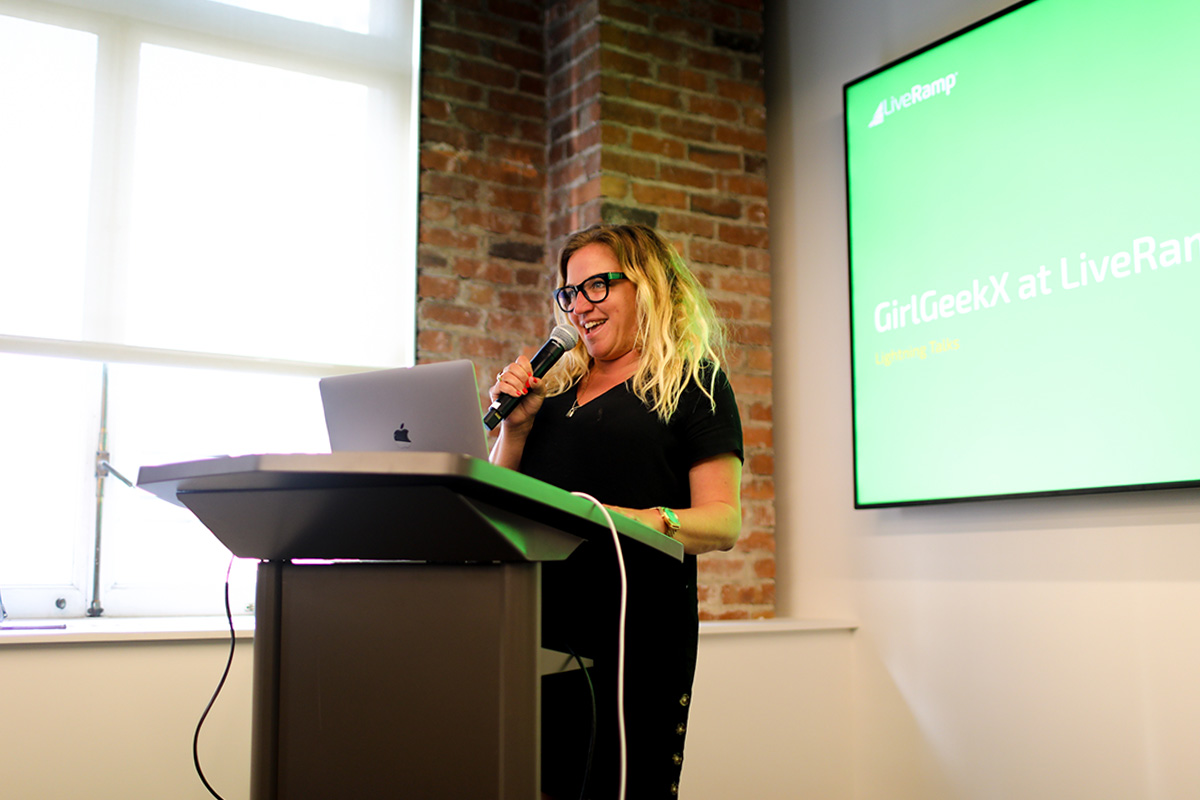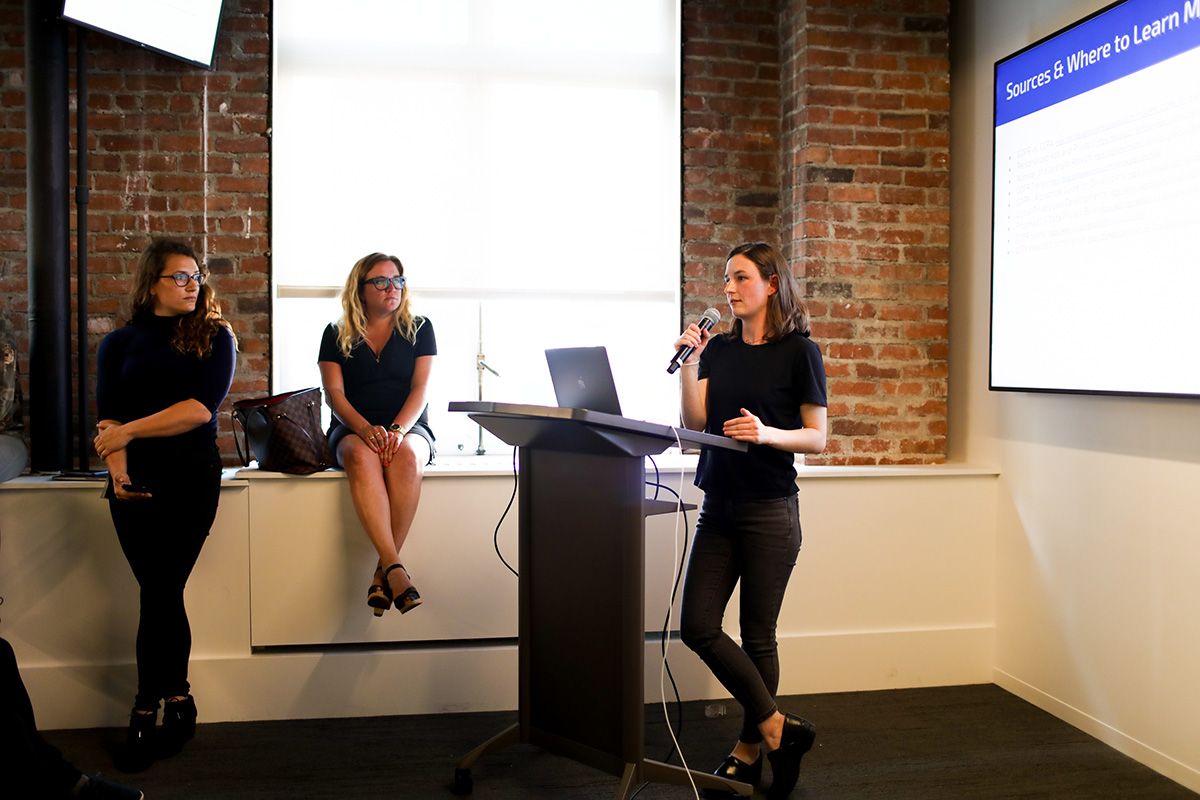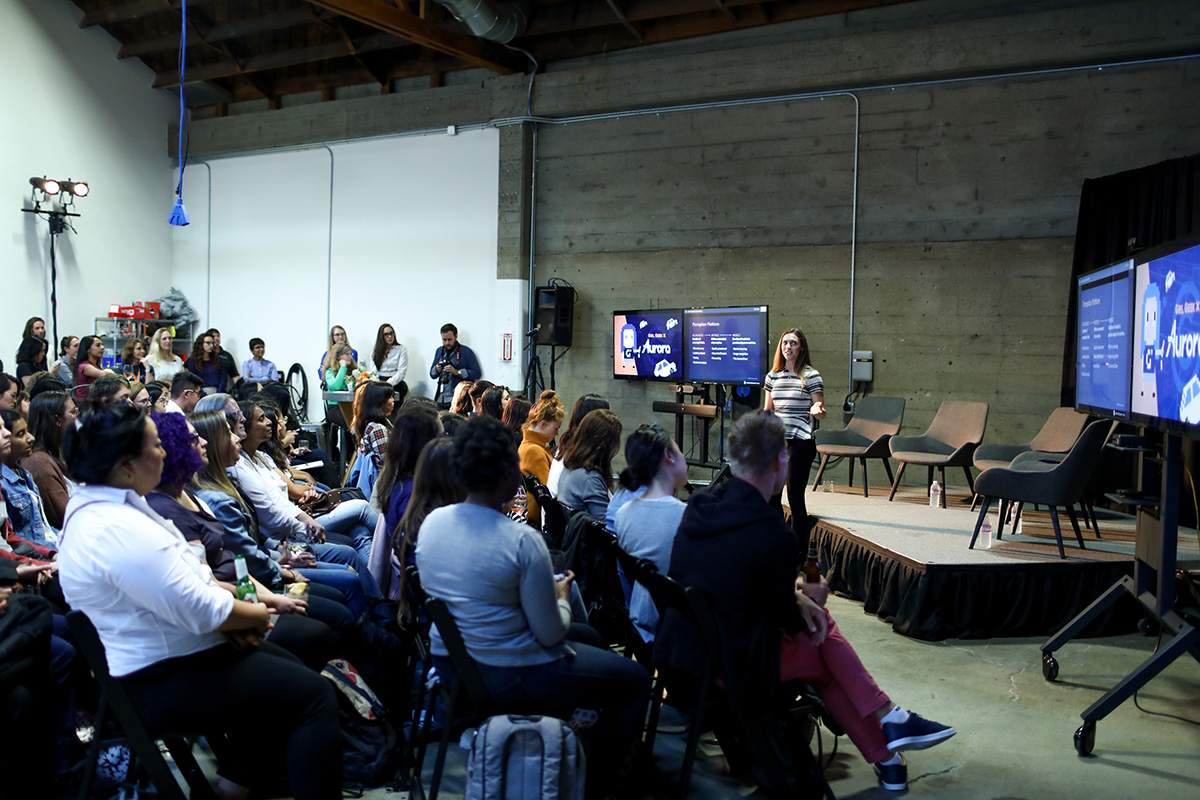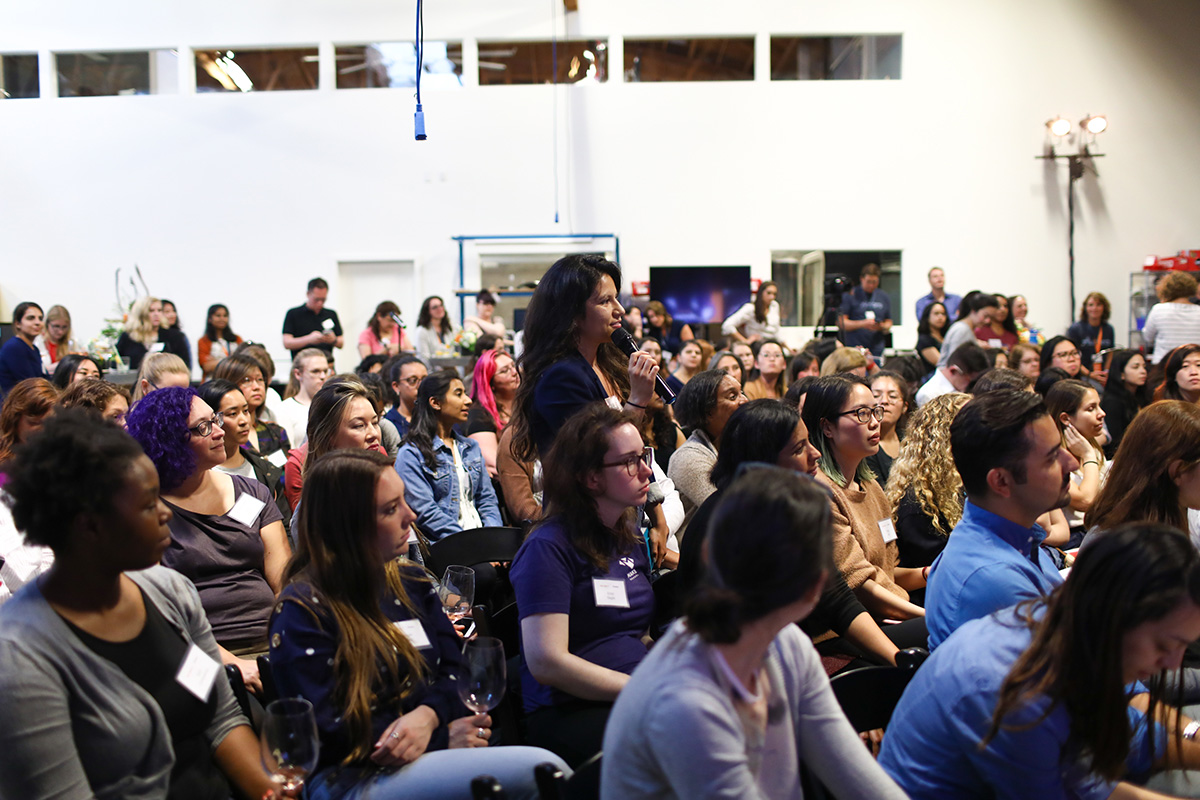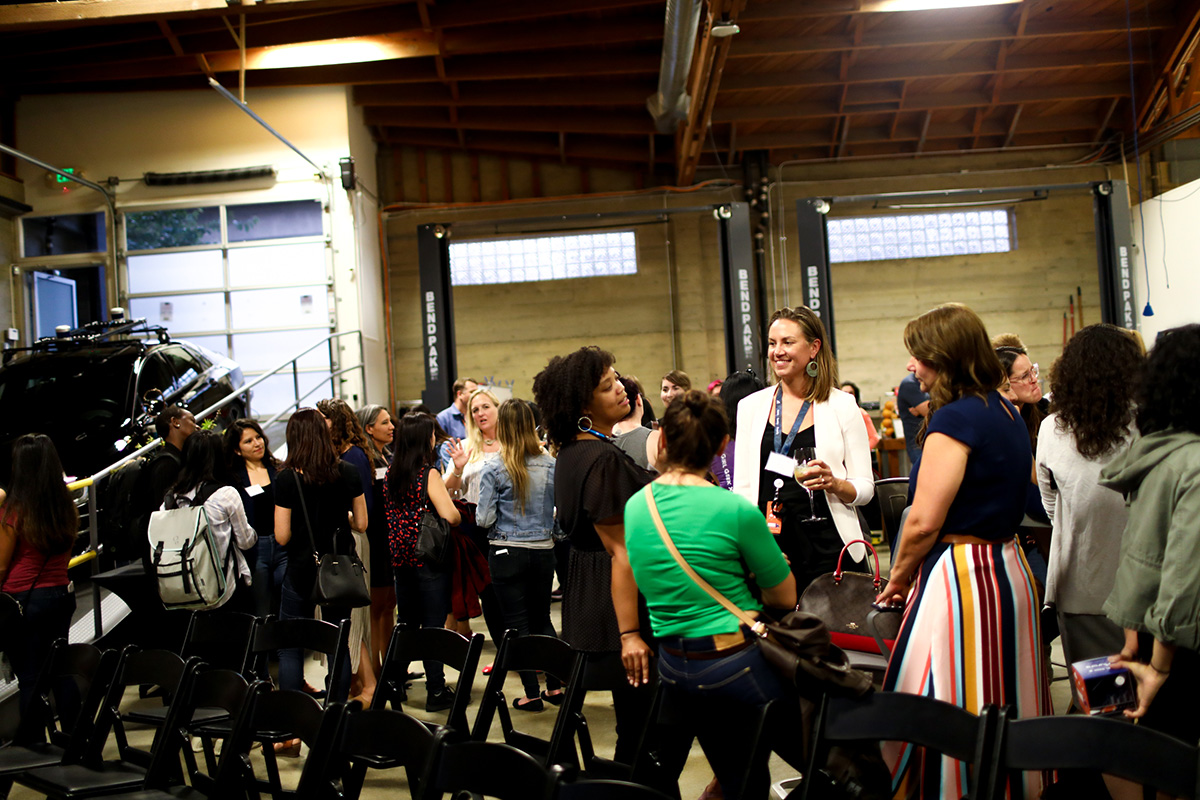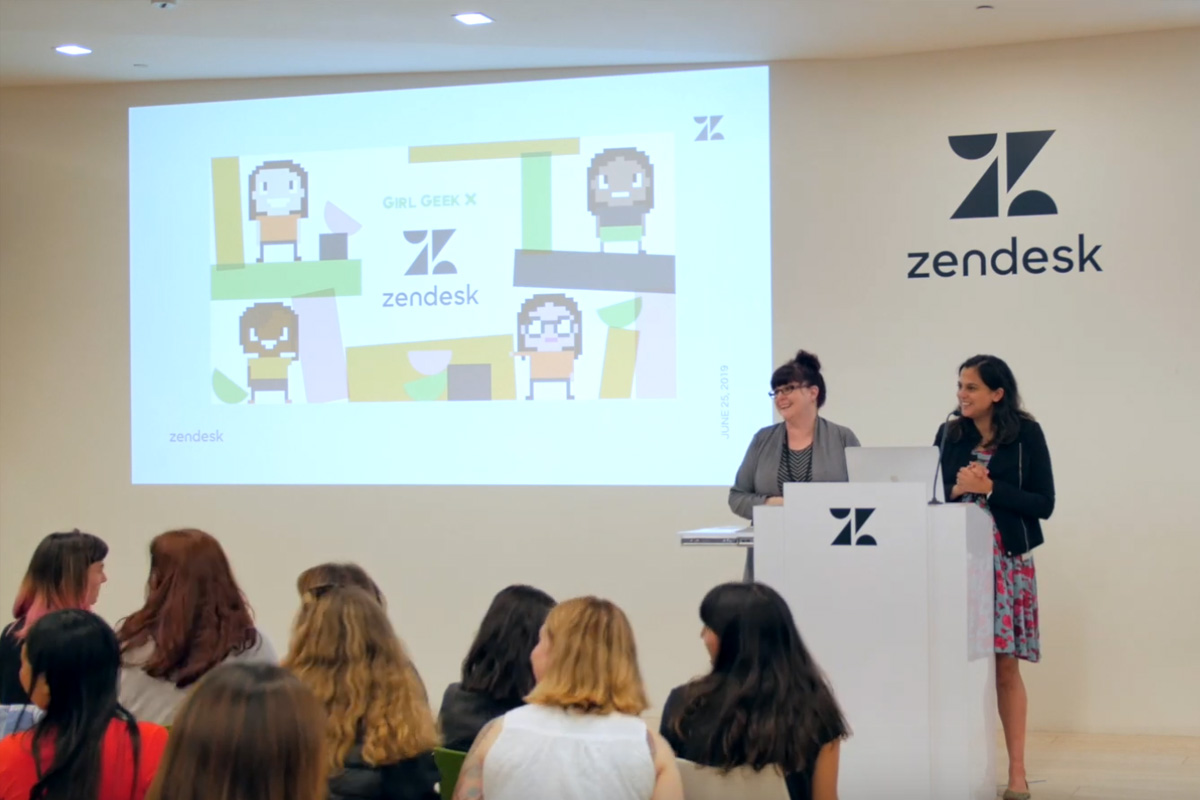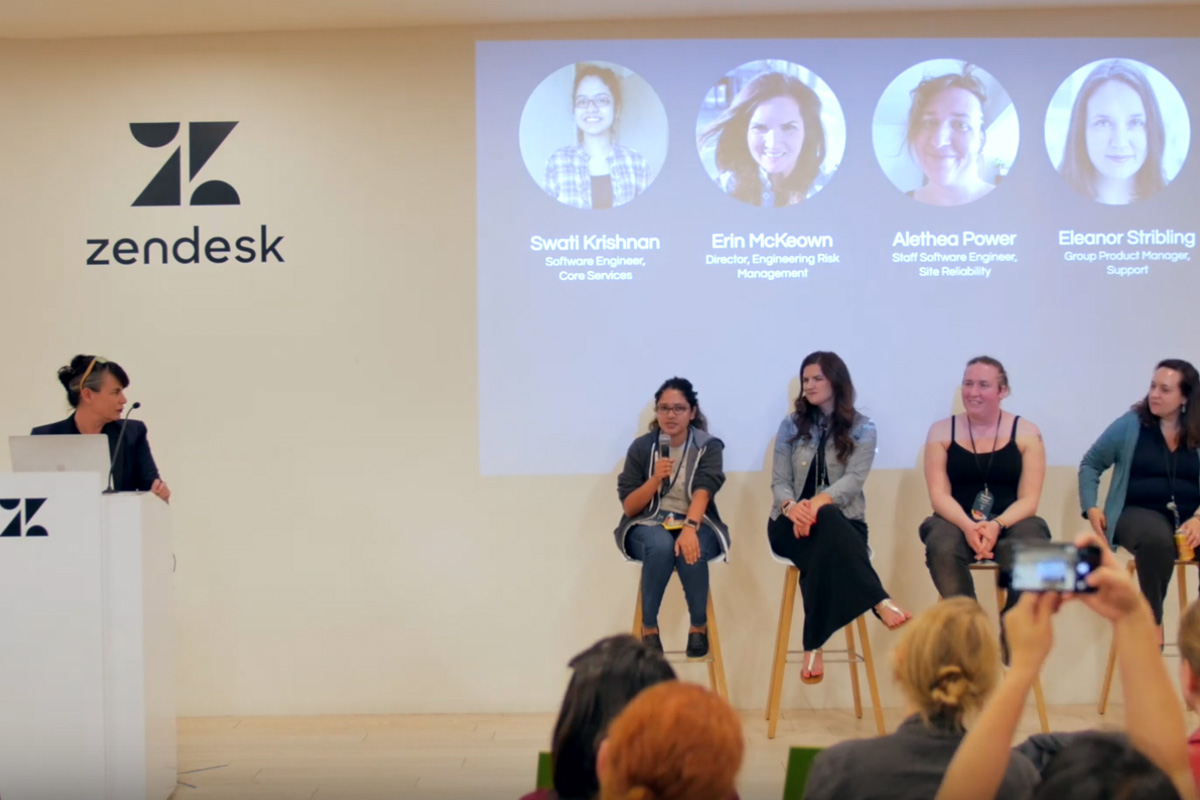Like what you see here? Our mission-aligned Girl Geek X partners are hiring!
- See open jobs at Intuit and check out open jobs at our trusted partner companies.
- Find more Intuit Girl Geek Dinner photos from the event – please tag yourselves!
- Does your company want to sponsor a Girl Geek Dinner in 2021? Talk to us!
Transcript from Intuit Girl Geek Dinner – Lightning Talks:
Angie Chang: Thank you to everyone for coming out tonight to another Girl Geek dinner at Intuit. I know we were here five years ago and had a terrific time and this time it’s going to be even better. In case you missed it, there are amazing demo stations with engineers and product managers speaking and giving talks about what they’re working on – and donuts. So, they’re out there and thank you so much to the folks at Intuit for hosting us again. This is an amazing welcome. The campus is even more beautiful than I remembered and thank you so much for bringing these amazing women together.
Gretchen DeKnikker: Hi, I’m Gretchen. In addition to doing these almost every week, which if this is your first event, raise your hand. Okay, so now you know that we do these almost every week, so you’ll be on our mailing list, come check out more of them. We also have a podcast, we’ve done like 20 episodes now and we would love some feedback because we’re thinking about what we want to do for the next season.
Gretchen DeKnikker: So, mentorship and career transitions and switching job function and the definition of intersectionality, like all sorts of stuff. So definitely go check that out and rate it and please give us your honest feedback because that’s the only way we’re going to get better. Then we also have … We’re going to do our virtual conference, our all day online conference. I don’t know how many of you guys have come the last two years but it’ll be just before International Women’s Day on March 6th.
Gretchen DeKnikker: So keep an eye out if you think you might want to have your company participate or if you might want to be a speaker, then start thinking about those topic ideas and then we’ll let you know when we’re sort of ready for all of that. If this looks like a good time, you could do it at your company too. So, just email us or grab us. Our information’s everywhere on the web and we’d love to talk to you about it. So, thank you.
Tracy Stone: Thank you. So welcome to Intuit. We are so thrilled to have all of you here tonight and thank you to Angie and the Girl Geek team for partnering with us on this wonderful event. For those of you who we haven’t had a chance to meet, my name is Tracy Stone and I lead the Tech Women Intuit initiative here at Intuit, and that initiative is sponsored out of our CTO’s organization as an initiative to attract and recruit, retain and advance women in technical roles.
Tracy Stone: So an event like this is so wonderful for us to partner with Girl Geek and to be able to bring the community together as we build connections and empower our women in technology. For those of you that aren’t familiar with Intuit, I hope you got a chance, as Angie said, we had some amazing demos from our technologists of some of the technology that we’re developing as we are in our mission.
Tracy Stone: Our mission at Intuit is to power prosperity around the world. We are a global financial platform company, makers of QuickBooks, TurboTax, Mint, and so I hope tonight you’ll get a chance to learn more about Intuit, about our products and the technologies. In addition, we featured some of our small business customers today, so I hope you got a chance to interact with them, get some of the swag to take home, some cool stuff.
Tracy Stone: So I hope you got a bag and got to take home some of those, some swag and the treats from our small business customers. So tonight we have amazing program in store for you. We’re going to start with a fireside chat with our CTO, and then we have some of our technologists and leaders across the company going to share some of their lightning talks with all of you. In the middle of all that, we’ll offer raffle prizes throughout the evening.
Tracy Stone: So, we’ll go ahead and get started. I want to introduce our first talk, which is a fireside chat with our CTO, Marianna Tessel. Olga Braylovskiy will be leading the chat with Mariana. Olga leads HR for our technology teams and partners closely with Mariana and all of her organizations on talent related items. Mariana is our CTO and as our CTO she oversees technology strategy and leads our product engineering, data science, information technology and information security teams worldwide.
Tracy Stone: She joined Intuit in 2017 to lead product development in our small business and self-employed group. Before Intuit, she was an executive vice president of strategic development at Docker and she’s held engineering leadership roles at VMware, Ariba, And General Magic. We’re so thrilled to have both Olga and Marianna with us tonight.
Olga Braylovskiy: All right, welcome everyone. What a turn out, incredible. Lots of power in this room. So, let’s start, Mariana, with you sharing a little bit of your career journey and how did you get you this amazing role of being CTO at Intuit?

Intuit girl geeks: CTO Marianna Tessel shares her career journey with VP Olga Braylovskiy at Intuit Girl Geek Dinner in Mountain View, California. Erica Kawamoto Hsu / Girl Geek X
Marianna Tessel: Wow, well, thank you. First of all, thank you everybody for coming in today. So wonderful to see so many geek women, I love it. So, a little bit about my journey. I’m an engineer in my background, so I studied engineering and then I worked as an engineer for quite a long time. I actually started, I’m from Israel. Anybody from Israel here? Whoo, hi, shalom.
Marianna Tessel: So, I started in the Israeli military as an engineer. So I worked there for some time and then I came here to the US after that and I worked in a company that was trying to do devices like iPhones and we weren’t successful, but there was a documentary on the company, it’s called General Magic. You should look it up. It basically says that almost any device today, you can trace back to the roots of that company because the people that worked on iPhone and on Android both came from General Magic.
Marianna Tessel: So that was actually a real pleasure to work with an amazing set of people and doing something so like envelope pushy. Is that a thing? Yeah, pushing the envelope and then just thought I’ll use it in a different way, why not? Then actually I worked in other companies. I worked at Ariba, et cetera, but actually at General Magic I became a manager. I didn’t expect that, they had a need for a manager and they came to me and I said, what me? And then I said, actually, I really like it and I started my leadership career then, and from there on I was a leader in multiple companies.
Marianna Tessel: Then, just before actually coming to Intuit, I spent a long time in infrastructure. So that means that VMware and Docker. VMware by the way, I learned way too much, more than I ever wanted to know about storage, network compute and whatnot, really down in the guts of systems. Then when I came to Docker, that was amazing because that was like a start-up and we were changing the world and that was a really great experience.
Marianna Tessel: But I decided to join Intuit and to your question, Olga, I’m trying to answer your question. To your question, how I became a CTO, I think that I spent a long time as actually an engineer and then I became a leader and kind of grew with different roles, and because I had really different roles, actually I think I had like different perspectives and sometimes it’s luck, sometimes I grabbed the luck when I had it and here I am and I’m really happy about that.
Olga Braylovskiy: Luck is largely about preparation and clearly you had a good one. You should also mention how passionate you are about people and technical talent, which leads us to another question. Intuit is a really special company, a little plug-in for Intuit and we have amazing culture and we have very unique engineering culture that I know you’re super passionate about. So what’s unique about our engineering culture?
Marianna Tessel: Yeah, I think Intuit is really known for its culture and I knew it before coming to Intuit, but I think what’s really unique about Intuit and for engineers here is that you actually get to work on things that are really meaningful for lives of people, and that is a great feeling. You heard our mission is to power prosperity around the world and you saw some of our customers here, and when you work on something that you feel fundamentally touches the lives and people and really help them, that is really, really powerful.
Marianna Tessel: At Intuit, we are very good about looking at it this way and not just building awesome technology, which I’m really passionate about, but also thinking about how it helps our customers. So I think that intersection of really working on great technology and being able to, across the stack, really exercise your craft as an engineer, then working on a mission that is meaningful and then as a company having this culture where it’s really welcoming and nice, and just kind of not that very cut throat, et cetera.
Marianna Tessel: So, it’s kind of unique in its culture of how it’s a very welcoming of people and I think that’s why we actually have also actually high percentage of women relatively because we’re a very welcoming culture where you can feel like you can come in and be yourself, a lot more than I’ve seen in other companies.
Olga Braylovskiy: Awesome, so we use the word awesome a lot and that applies to our culture.
Marianna Tessel: That’s awesome.
Olga Braylovskiy: You touched on amazing, kind of use of amazing technology and being part of our culture. What are some cool and interesting uses of technology, especially more modern tech really as we try to fulfill on our mission of powering prosperity around the world?
Marianna Tessel: Right, and as all you guys you know, we declared our strategy to fulfill that mission to be an AI driven expert platform and what that means … And by the way, this is one of the things about Intuit that I’ve learned. You are very clear about our mission, our strategy, our values. In the beginning, I was like, wow, that’s really heavy, but I actually learned to really, really appreciate it and the clarity that it brings.
Marianna Tessel: So, I really appreciate it now. But our strategy is to be an AI driven expert platform, and what that means is actually it’s a combination of technology and being a platform, both in terms of how we build product, as well as interacting with other entities and actually people because what we have also coming to our platform are real people experts and bless ya, accountants, et cetera. So we are allowing, not just we’re building a great platform but we’re allowing people to be very, very productive on our products.
Marianna Tessel: The AI part is the one that I’m recently very excited about because this is where we really use innovation and a lot of kind of industry buzzwords and applying them to customers to again, like in a real life changing way. We actually we’re … One of the things and nice things we’ve done, we actually defined AI for ourselves, and we said, when we talk about AI, what we mean is machine learning, knowledge engineering and natural language processing.
Marianna Tessel: Now, you’ve probably heard about machine learning and natural language processing, but just to give you a bit of a taste of knowledge engineering, it’s actually about taking rules and relationships and turning them into code. Where it becomes very interesting for us is as you know, we have a leading tax product and other products that have to do with compliance, and what it enabled us to do is really encode compliance in a super efficient way. So that’s kind of one of the things we’re super excited about.
Marianna Tessel: So here is like, on the surface, a problem that could be like sounding to an engineer, slightly boring like compliance and you go ahead and you end up with a technology that’s actually really amazing and completely revolutionizing that field. So, that’s some examples that I’m excited on.
Olga Braylovskiy: Awesome, so if you reflect back to earlier in your career, what is something that maybe a true that you held at the time that you no longer hold true? Like you kind of reevaluated, your perspective shifted.
Marianna Tessel: How early? Like yesterday or?
Olga Braylovskiy: When we’re saying earlier, think back maybe 10, 15 years and I know that our perspective shifts all the time. Something that would be useful especially to this group of geeks who aspire to be the CTO.
Marianna Tessel: Right, I actually … There’s a lot of things that I change my perspective about, but let me kind of touch on a few that came to mind when you asked. The first one is how much do I want to plan my career or not? So, early on I was like this, I would say, like a leaf in the wind that I was like, oh, whatever that takes me. I’m like that sounds interesting, that sounds interesting and I didn’t really plan my career.
Marianna Tessel: I was like, oh, whatever is the next thing, if it sounds good, I’ll just go with it. What I realized at some point is that I need to have a little bit more direction to my career and not necessarily that I have to decide that I want to be like a CTO or whatever, but just kind of think about how the combination of my experiences is actually adding up and where am I going is not just like, oh the cool people. It’s also like, hey, what does it mean? How is it all adding up as a path?
Marianna Tessel: So that will be like one thing that at some point I was like, I’ve started to think … So I’m not a huge planner of my career, but I will be thoughtful about, you know what, I don’t think I’m learning anything here or I don’t think this is like … Doesn’t sound like the traditional step, but I think I’m going to learn a lot, so I want to go and do that. Like an example would be at VMware and it would be at Docker.
Marianna Tessel: I did end up doing a lot of business development while still having an engineering role and I’ve learned a ton from it. That’s something that early on I would be like, no, I’m an engineer, don’t talk to me about anything else. Another thing that I changed my mind about is around leadership. Early in the leadership … And maybe again because that’s kind of a little of what was expected from me, at least I felt, is like I was really focused on the people leadership side.
Marianna Tessel: This is an area that I’m gravitating to anyways. So I would really think myself as a leader of people and I just focused on that as in my leadership, and what I’ve noticed is that I actually really need to continue to develop my craft and I also need to be a technical leader, not just kind of a people leader. So that’s another thing that I changed my mind about how I lead and now I really focus on making sure that I follow technology, I understand technology, I understand the craft to a really big depth, not just focusing on leading people and that’s just like its more fun, but it’s also like, I feel like I add a lot more value to companies when I do it this way. So, I can also talk about other things about learning to be more assertive and things like that, but at a high level, those are a couple of examples.
Olga Braylovskiy: Awesome, last question. I think we have time for one more question. This is super powerful event. We’re all here to learn, share ideas, network. What’s your perspective on leveraging this type of event to the fullest? And just advice on how to make it most effective as a contributing factor to developing relationships and career.
Marianna Tessel: One of the things that actually I’ve learned in, again in my path that your network is one of the most important things that are going to help you in your career. Sometimes you find it in an unexpected places, so just to give you a few ideas around it. When you think about network is like the people you know then later on they will go places, or you need something, or they need something and then you have that connection to really make a dent for them, for the companies, for you, for your career, for your company or sometimes even just getting advice when you need it or sometimes it’s finding that next job when you need it, whatever that is.
Marianna Tessel: So developing a network, if you take one thing away today to at least kind of from what I’m have to offer, developing a network is something super important and I will really focus on that. Then the … What I will say that it’s really important to develop a network, it cannot be like this give and take. You can’t say like, oh I have a bunch of people that when I need them I’m just going to call them, is you need to think about it.
Marianna Tessel: You want to give your network more than what you are taking and you want to really develop great relationship and really, really think about it. Not just like something that you, a tool but something that you’re really caring about. So again, I always focus on am I giving more to my network than I’m taking, because that’s what I think is like a best set up. Of course you don’t want to have people that just always take, take, take from you and will never … There when you need them.
Marianna Tessel: That’s not good part of your network, and then how you develop your network is through events like that. You meet people, you exchange maybe information, then you can follow up. Maybe you have like, you decide to have a coffee or et cetera, but invest time in that. When you think about your day and when you think about your week or your month or whatever, make sure you allocate time to develop your network and to again, make sure you meet with people, you continue getting advice, you continue offering advice, and remember the golden rule, you give more than you take. So anyway, that will be my advice.
Olga Braylovskiy: Awesome, thank you so much for all the insights, Marianna. One and only Marianna Tessel.
Marianna Tessel: Thank you, Olga.
Olga Braylovskiy: You’re welcome. We like hearts in Intuit. That’s true though.
Tracy Stone: You can put those there. Thank you, Marianna and Olga, we appreciate you being here and your wonderful words of advice. Okay, so as promised we’ll do our first raffle and our raffles tonight are some goodies from our small business customers. So, our first raffle is from the Basik Candle company up in South San Francisco, and so I need to draw a ticket. Everybody have their tickets ready? You didn’t get a ticket?
Audience Member: I didn’t get to.
Tracy Stone: Okay, so ready? It’s 691156. Right here? No worries, there you go. From Basik Candle-
Audience: Is this right, 69?
Tracy Stone: Yeah, you are winner, congratulations. Thank you. Okay, so next up we’re going to hear from Rajashree. So Rajashree leads our engineering team for Intuit’s external developer platform and third party app experiences, enabling an ecosystem of thousands of applications that connect to Intuit’s QuickBooks platform. She’s passionate about building purpose-driven engineering teams with a customer first thinking and an inclusive culture. Before Intuit, Rajashree held various engineering roles at PayPal. Thank you, Rajashree.
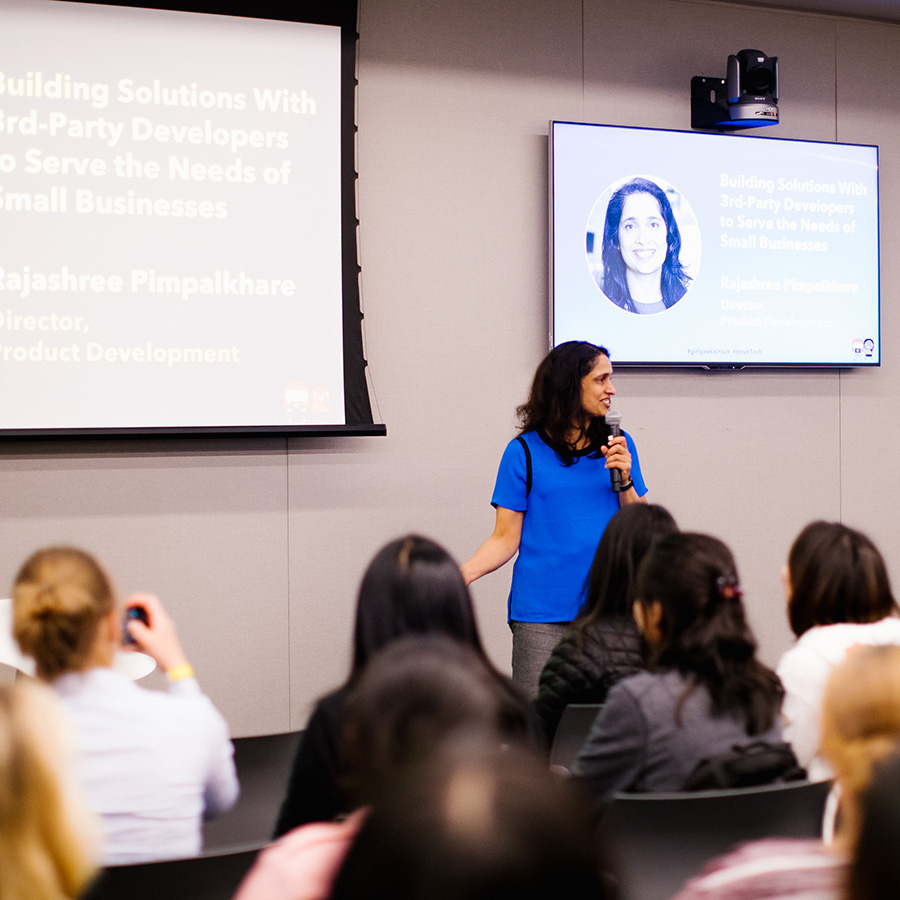
Director of Product Development Rajashree Pimpalkhare gives a talk on “Building Solutions with 3rd-Party Developers to Serve the Needs of Small Businesses” at Intuit Girl Geek Dinner. Erica Kawamoto Hsu / Girl Geek X
Rajashree Pimpalkhare: Thank you. First of all, let me say this is amazing to see all of you guys here and then secondly, how do I get to follow that? That’s really not fair, but I’ll do my best. So, I lead engineering for Intuit developer group and my focus and my team’s focus is empowering developers that want to work with our customers, deliver solutions to our customers that work with QuickBooks, which is our main product for small businesses.
Rajashree Pimpalkhare: I always like to start with customers. Actually, it’s the first thing I learned when I joined Intuit, that the customer is always in the house, and for us customers are three main type of customers, small businesses, self-employed and consumers. The key thing about all of these personas is they have their financial lives mingle between their business world and their personal world. So most small businesses will have bank accounts that they keep moving money from their personal account to their business account and so on.
Rajashree Pimpalkhare: So we always think of all of those customers in one breaststroke while we may provide different products for them. Then at the bottom you see our partners, so accountants, developers, financial institutions, mega platforms like the Amazons and Googles of the world, educational institutes and governments. These are all the partners that we work with. So, at Intuit we really believe that we want to power prosperity of our customers and we want to bring our partners along, and one big constituent in this part among the partners, are the third party developers.
Rajashree Pimpalkhare: So this is a little bit of geeking out. When you think of third party developers working with QuickBooks, they want to connect their applications to QuickBooks in one of three different ways. Before I go into the specific ways, let me put your mind to who are these developers, what are these apps and what is QuickBooks?
Rajashree Pimpalkhare: So, QuickBooks is our product that does accounting for small businesses. We offer them a payment solution. We offer them payroll solutions, we offer them capital, so we take it off of their financial lives. But these same customers think of like a food truck that you might have seen when you entered building 20. The food truck has things that they need to order. They need a POS system that they need to run credit cards through. They might have some discounts or coupons that they want to give out and those go through social networks and so on, so they use many different apps.
Rajashree Pimpalkhare: A typical small business uses anywhere from four to 15 apps to run their business and it is really critical that their data from these apps flow seamlessly into QuickBooks. Because at the end of the day, this is where they go to understand whether they’re making money, they’re losing money, or how are they going to pay for their dinner the end of the week, right. So there are three ways in which the platform enables us to or enable the third party developer to connect their app with QuickBooks.
Rajashree Pimpalkhare: The first one is data connections. So, this is what most of our developers use. So an eCommerce app, or a POS app, or any kind of other app that’s doing financial transactions for the developer can write that data into QuickBooks. So that can be reconciled into our books if it’s inventory for a product based business. Somebody is selling something on Shopify, the inventory can reconcile with QuickBooks.
Rajashree Pimpalkhare: If it’s a set of customers and a general contractor that’s doing 10 different jobs or a plumber that’s doing 10 different jobs for 10 different customers, those customer names can all come in here and they can understand where they spend money versus where they invoice their customers. So that data flowing in and out. So everything works together is the primary use case that our platform enables. The second use case is for certain types of experiences.
Rajashree Pimpalkhare: When small businesses are into QuickBooks and they’re trying to run their business, they don’t want to have to go and open up another app. So this might be something like you are in QuickBooks and you want to pay your bills. Now, we don’t offer bill pay as our own capability, but we do power it through a partner. If you are a small business in the UK and using QuickBooks, you can actually run payroll through a product that’s run, that’s developed by a different company but the experience is seamless and the platform underneath enables that. Then the third piece is we want to be where our customers are.
Rajashree Pimpalkhare: So, if you are in Google and if you are responding to some emails from your customers, you are able to invoice your customers right from there, from Gmail and that invoicing is powered by Intuit. So the three kind of ways of allowing integrations or ways for third parties to integrate with us, are data connections, so everything works together.
Rajashree Pimpalkhare: Powered by partners, so seamless experiences for our customers where they don’t know where our experience starts and ends and the partner experience starts. The third piece is powering through partners and this is really critical when we want to actually go and serve customers where they are. So what do we do with this? Why is this so important? So we are the small business platform of choice in the United States and increasingly in the global countries where we are.
Rajashree Pimpalkhare: The reason that’s true is because we have over four million customers that use QuickBooks today and for all of those customers, they have needs beyond what QuickBooks provides. So small businesses say, I need additional tools beyond QuickBooks to help me run my business and I would rather get it from Intuit because I trust Intuit and Intuit knows what really is needed for my business to run, and for my business to work, and for me to be profitable.
Rajashree Pimpalkhare: Then the developers need access to customers because if you are a small developer creating a niche app for a specific segment of small businesses, it is incredibly difficult to get them to know you and get them to pick you. There are so many different channels, but if they came in through, we have an App Store that the QuickBooks customers can view. If these developers put their apps in the App Store, they have access to all of their customers and they can put forth a value proposition and reach them.
Rajashree Pimpalkhare: So the developers come to us because they need access to customers to build a business that can grow and be profitable and we sit in the middle of it being able to really power that network effect. So it’s actually really, really gratifying because we work for developers and we work for customers and it’s great to be able to connect the two. A lot of build-outs. So I love this slide because it tells you a little bit about what kind of … So it tells you multiple things. First it tells you look at how big our ecosystem is.
Rajashree Pimpalkhare: All of these apps that show up here are connected to QuickBooks in one of the three different ways that we looked at. The second thing it tells you is look at how difficult it is for small businesses to really know what they want and what they need and the QuickBooks at the center is where we really take our role really seriously. We want to recommend the right apps to our customers. We want to make sure they’re successful with those. We want to make sure they know exactly how they interact with our products and so on. So this is just to tell you where we are today.
Rajashree Pimpalkhare: So I joined Intuit five years ago. I think Tracy said I came from PayPal and I came from a world where it was all about money, and all about revenue, and all about the money that came into the pocket of the company. I love PayPal as well, by the way, but at Intuit it’s just a little bit different, right? The purpose is just a little bit higher and the passion you can bring to the table is just that much bigger. In the last five years we have gone from about 700,000 QuickBooks customers to over four million.
Rajashree Pimpalkhare: I think the number is 4.2 million today. 40 apps that were on the App Store to more than 700 and one in five customers of QuickBooks today use at least one app, and we are continuing to work on it and continuing to grow it. So just super proud to be associated with the Intuit developer group to be working here and we are the global trusted platform of choice. So, with that…
Tracy Stone: Thank you.
Rajashree Pimpalkhare: I assume you’re not taking questions now, but I love to talk to you about it after.
Tracy Stone: We would love for you to engage with our speakers after. We’ll have some time at the end of the session. So thank you, Rajashree. Now we’d like to invite Nhung up to our virtual stage up here, I guess. Nhung, you want to advance the slide. Nhung is the director of data science for our QuickBooks ecosystem and customer success data science teams. She leads the strategy and execution of applied machine learning programs that span the range of marketing product, forecasting, and other strategic capabilities.
Tracy Stone: Her applied machine learning teams build new to the world products and services backed by artificial intelligence to serve Intuit’s customers across the whole customer life cycle. So I’m excited to hear from Nhung. So let’s give Nhung a warm welcome.

Director of Data Science Nhung Ho gives a talk on “Using Machine Learning to Solve Small Businesses’ Problems” at Intuit Girl Geek Dinner. Erica Kawamoto Hsu / Girl Geek X
Nhung Ho: All righty, can you hear me? All right, so couple things as ground rules. I speak really quickly and I tend to pace. If I walk into these chairs, feel free to laugh at me. All right, so just a quick introduction about myself. I’m actually a former astrophysicist turned data scientist and one of the things I’m super passionate about is actually using math and code to solve real world problems. That’s why I escaped from looking at the stars, actually looking at people and turning my gaze down.
Nhung Ho: The other thing is I also love food and so if you’re traveling to any city and want restaurant recommendations, I have a running list. I made a Google maps, I pin everything and I have a list of all the dishes that I liked. So I’m happy to share that with anyone. All right, so I’m here to talk to you about how my team uses machine learning to solve small business problems because the business of running your business is actually really hard and it all starts with starting your business, right?
Nhung Ho: You would think that like Michael Scott in The Office, when he says, I declare bankruptcy, right? You can say, I declare a business and then you have a business. But actually that’s not true and this is just the first six of 25 steps that you have to take to even start a business, right? There are a lot of questions that you have to answer before you even get your first customer through the door. Once you start doing that, then you say, okay, I expect that I’m going to open a clothing store.
Nhung Ho: I’m going to be able to dress women, make them happy, make them look good and everything is going to be awesome, dandy. I’m going to go home feeling great, but what you do is you actually go home to a mountain of paperwork, right? I know this really intimately because I have 10 siblings and five of them own small businesses and every day they go home, the stacks and stacks of papers, stacks and stacks of receipts.
Nhung Ho: It is incredibly hard to manage. So, while during the day you’re satisfying your customers, you’re doing what you love, you go home at night and you’re dealing with paperwork because you actually have to run your business and make sure that you have enough cash flow to continue serving your customers. Just a simplified view of some of the things you need to do as a small business, you need to track your expenses.
Nhung Ho: You’re going to go buy supplies, you’re going to go buy inventory, and you’re going to have a stack of receipts and invoices that you have to keep track of. If you drive for a living, you have to keep track of how much you use your car because that ends up being tax deductible, right? You want to be able to track your income so now you have bank statements to take care of. If you invoice people, you have to keep track of that as well. Then, finally at the end of the year, you need to make sure you’re tax compliant, right?
Nhung Ho: So if you’re a sole proprietor, you need to know about this thing called a schedule C and you then you need an EIN. So there’s a whole host of things that you need to be able to do and know and manage as a small business owner that I think a lot of us who don’t own small businesses don’t realize. So where do I come in, right? Why do you need an astrophysicist here at Intuit for solving these problems?
Nhung Ho: It’s because a lot of these things that are really rote, and boring, and tedious, you can actually make much easier using machine learning. So I’m going to go through two examples. The first one is on receipt tracking. So I mentioned that a lot of small businesses go out and buy a bunch of things. They need to be able to track their receipts. They need to be able to take those receipts and actually transcribe every single piece of information into an accounting system. In this case, in QuickBooks, right?
Nhung Ho: So if you as a human, you have to go through and scan this and say, where did I buy this from? What is the address? When did I buy it? What are all the things that I bought? What is the individual prices? And then decompose that one receipt into individual lines in there. Think about how much time that takes and how tedious it is.
Nhung Ho: So what that ends up doing is actually causing you to say, it’s not worth it, I’m just not going to do this and then you end up leaving money on the table because you could have deducted these. So if you can imagine, what my team did was we actually married computer vision and natural language processing. You can utilize an OCR system to go through and actually pick out every single character. You can figure out exactly where the bounding boxes are for each of these fields and then begin to lift that information out.
Nhung Ho: You can then use a deep learning system to say, okay, I know that when I see Aroma Cafe, that’s a vendor, and when I see that number format, it’s actually a date, right? We can use the latest deep learning technology, scan through the system that’s already been OCR, pull out that information and then make sense of it. Then finally put that into your accounting system and you’re done.
Nhung Ho: This system is 10 times faster than what a human can do and we can go and grind through thousands of receipts for you as long as you send us the image. That’s kind of the power of what machine learning can do to help a small business succeed. So the next example I want to talk about is mileage tracking. As I mentioned earlier, how many of you here know that if you use a personal vehicle for business purposes, every single mile that you drive is deductible at 54.5 cents per mile?
Nhung Ho: Actually, quite a bit. Actually, I definitely did not know that when I started this. But if you are a real estate agent and you’re driving between showings, that could be hundreds of miles per day. That’s a lot of money that you can deduct on your taxes. We actually have a product called QuickBooks Self-Employed, that makes this really easy for you. You turn on our automated mileage tracking service, we will say, okay, we know that Nhung traveled from point A to point B on this day and this is the distance that she drives, which is super awesome, except we don’t actually know exactly what the purpose was, right?
Nhung Ho: Because again, you need to be able to say, this trip is a business trip versus a personal trip. If I drive to the grocery store, I can’t deduct that on my taxes and if the IRS finds out, it’s not going to be good times for anybody. So you have to go in and say, is this a personal trip? Is this a business trip? And if it’s a business trip, why did you actually use your car for that purpose, right? So it’s multiple pieces of work.
Nhung Ho: So to give you a real example that I have scrubbed a lot of personal information from is, meet Claire. Claire works at City Hall during the day and she actually teaches piano on the side. These are all of the trips that Claire took. You can see that some of them are for business purposes and some of them are for personal, but there’s no real pattern that jumps out here. In an average month, she takes 200 trips and you can imagine that if Claire, like I am, there’s a huge procrastinator, at the end of the month, she’s got to answer basically 800 questions.
Nhung Ho: What was this trip? When did I take this trip? Where was I going and what was the purpose of this trip? Is it for because I’m driving to teach piano or is it because I’m driving to City Hall for my job? We don’t make that distinguish. We don’t distinguish that, you do it for us, but I can build a machine learning system that can do this in less than a second for Claire and that’s exactly what my team did. We utilized frequent pattern mining and we essentially automatically learn very personalized and highly individualized rules per user.
Nhung Ho: So we can group all of the trips on the left side that she took exactly to the same destination, show that to her and say, we think that this is a personal trip and if it ends up being a personal trip or a business trip, here is a deduction that you get. For our users, they take 50 million trips per year. Now you can imagine building a system like this that is scalable, extensible, and is ready to use for any new user who comes in.
Nhung Ho: So what I hope I showed you was how machine learning can actually make the business of doing business much easier, right? And it’s not … I can tell you it wasn’t obvious to me when I started here, why we need a data scientist to work on accounting. Isn’t it solved? It’s so old, it’s so boring. But I can tell you some of the most boring, mundane things are the areas that are the most exciting because those are the areas that have not seen innovation in a really long time and that’s where you can go in and make a difference. So thank you for letting me share those with you.
Tracy Stone: Thank you, Nhung. I don’t think you tripped over the chairs either, but that might be my job then, huh? Okay, one more raffle now. So get your tickets out and this time our raffle prize is from Origaudio in the set of very cool noise canceling headphones. You like this? Yeah, all right. Let’s see if I can pull your raffle card. Okay, it is 691056. Anybody? 691056. Here you go, I believe you. Okay, wonderful. All right, so next we have Kristina Fox, and Kristina Fox is our staff iOS engineer working on the QuickBooks Self-Employed iOS app.
Tracy Stone: She has spoken internationally at over 25 meet-ups and conferences, including Grace Hopper, iOS Dev UK. Were some people at Grace Hopper a few weeks ago? iOS Dev UK, WeAreDevelopers World Congress and many others on topics ranging from Apple watch development to diversity inclusion. So thank you Kristina for being here and let’s give her a warm welcome.

Staff iOS Engineer Kristina Fox gives a talk on “Using Mobile Capabilities to Save Time and Money for the Self-Employed” at Intuit Girl Geek Dinner. Erica Kawamoto Hsu / Girl Geek X
Kristina Fox: Thank you everyone. Okay, so we’re going to be talking about using mobile capabilities to save time and money for the self employed, and this is really a topic that’s near and dear to my heart because, well I’m an iOS engineer and it’s basically one of the most versatile platforms out there. Okay, is there anyone here that doesn’t have a phone on them right now?
Kristina Fox: Exactly, so that’s why this is one of those platforms that’s literally always on you and it can make such a huge difference in your lives than it already has, considering the fact that none of us really travel without phones anymore. Okay, so let’s get started. Just to give you a bit of context, I work on QuickBooks Self-Employed, it was actually the app that Nhung talked about earlier, and for those of you who aren’t familiar with it, it is an app that helps freelancers and contractors help manage their business finances.
Kristina Fox: So she talked a little bit about the mileage tracking. We also do transaction and expense reporting and also invoicing. So there’s lots of really cool stuff that our app does to help all of those self-proprietors out there, the sole proprietors out there. If you think about it, the types of people that we help are people like this freelance photographer out there or maybe even the Lyft or Uber driver that took you here today.
Kristina Fox: So lots of really interesting industries that we can also help out there. Okay, so the next thing that I basically want to dive into is specifically a project that I worked on and developed called Receipt Capture. This is this is one of these most probably my favorite project that I’ve ever worked on here, so it’s really fun for me to share this with you. Okay, so let’s take a step back and say, oh, we decided to go shopping and this is just to set some context about why receipts are so important to our self employed people, right?
Kristina Fox: So we decided to go shopping and we found a really amazing dress. It looked awesome on you in the dressing room and you decided to buy it and bring it home. But once you got home, you really … It ended up changing colors on you. You didn’t really know what color that dress was. Was it white and gold? Was it blue and black? You’re not really sure anymore. So, well, okay, you decided the blue and black doesn’t really work for you and so you want to return it and what exactly do you need usually to return things to a store?
Kristina Fox: Receipts, exactly. So receipts are really important to us as proofs of purchase as consumers, but for our small businesses, they’re really important to help prove that the things that we’re buying are actually business purchases and so this is really important, especially if the IRS comes to audit at some point, you need to be able to prove that the things that you purchased at the end of the day are actually for your business.
Kristina Fox: So, let’s talk about the basic Receipt Capture experience and so I direct your attention all the way to the left side. Usually you’ll hook up QuickBooks Self-Employed to your bank account and you’ll see the list of transactions coming through from your credit card or your checking account. From there, if you have a receipt for Starbucks for example, you’ll want to tap on Starbucks and then that will pull up a detailed view of your transaction.
Kristina Fox: From there you can tap, attach receipt and then you’ll be able to either take a photo or choose from your camera roll if you decided to take that photo earlier. That’s fine, pretty simple experience. You’re really just attaching a photo to a transaction, but one thing that’s kind of interesting about this is that if you’ve ever gone into your checking account or your credit card account and you just bought something, you’ll notice that there might be a pending transaction, right? It means that it hadn’t exactly cleared yet because maybe the restaurant doesn’t have your final total or your credit card is still being authorized.
Kristina Fox: So it can take generally about one to two days for these pending transactions to clear and unfortunately until that time we can’t really attach any receipts to it because it’s not a real transaction at that point. One to two days might not sound like very much time, but really anything can happen in these receipts in that one or two days, anything at all.
Kristina Fox: So what do you do? What do you do when you lose that receipt? Well, hopefully with our new enhanced Receipt Capture experience you won’t have to find out. So I’m going to do a quick demo of the new enhanced Receipt Capture experience that I ended up building for QuickBooks Self-Employed and this is going to be fun to juggle. So hopping in, I’m going to go ahead and end the show and I bring up my phone screen here. So this is the QuickBooks Self-Employed app. I’m trying to make this bigger.
Kristina Fox: You can go into the transactions tab where you can actually snap a receipt. So if you remember before we had to go and tap into an individual transaction to take a picture, well now you don’t really have to do that anymore. So you go into here, we’ll tap snap receipt and then we bring up this new camera view that we have, and so what’s cool about this is it actually does the cropping for you. So I’m shaking a little bit too much right now.
Kristina Fox: Demos are always nerve wracking. Okay, so we’ll steady. Okay, so now we’re able to get a cropped version of our receipt photo here and if you ever wanted to mess around with it, say it didn’t quite crop correctly, you could even go in, it takes you back to that original photo. So then you can manipulate those crop points or you can even rotate that image. So, there’s lots of really cool image enhancements that you can do here, and then from here all you have to do is hit at the bottom, use this photo and it disappears off. It gets uploaded to our service in the background and that’s it.
Kristina Fox: That’s all you have to do now. So this is our new enhanced Receipt Capture experience. So what exactly is happening here? Well, in the background we start off with QuickBooks Self-Employed. From there it actually gets uploaded to our document service. So this is where it actually stores that receipt image for you and then from there it goes to our data extraction service.
Kristina Fox: So, it’s something that Nhung was alluding to earlier where we can actually go and run optical character recognition on that receipt itself and then pull out the data that we really care about. So that’s stuff like, again, the vendor at the top of the receipt, we’re looking for the date, the total, and the credit card number too. So we can pull out all of that receipt data for you, and then we do automatic matching.
Kristina Fox: So now we go back into your list of transactions. Instead of actually having to go in and find that Starbucks transaction again, this algorithm actually takes that receipt and automatically looks at the data that’s coming in from that transaction and it attaches it for you. So it’s literally you take a picture and then you just forget about it and it’s already in your account, all done. Yeah, it’s literally a life changing event.
Kristina Fox: So what are some of the mobile capabilities of this? Well, obviously we’re using the camera to take a photo. We have a lot of touch … We have the touch screen capability where we can actually manipulate the photo if we need to, and we’re also running a lot of image processing algorithms in the background in order to make sure that the photo is usable. So you saw that it was telling me to hold steady.
Kristina Fox: In some cases, if there’s not enough light, it will tell me, oh, you need to add some more light to the background’s too dark, things like that. So there’s a lot of really cool things that are running in the background, just doing image processing there. It’s also a very on the go capability, like as you can see, a lot of the people we’re supporting are Lyft drivers. They’re a freelance photographers, they’re always constantly on the go, they’re gig economists and so they need to be able to have this type of capability wherever they’re going.
Kristina Fox: Of course, on one last thing, if you’re using the iOS platform, you might be familiar with Siri shortcuts, and so if I hop out again and on my phone. Okay, so let’s tell Siri, snap this receipt. It hops directly into that camera. So now the user doesn’t even have to go in and launch QuickBooks Self-Employed. You can just add a Siri shortcut with your own custom phrase and then it will go into the exact view that you need.
Kristina Fox: So we’re really taking advantage of all those platform capabilities here too, and here’s a look at what that looks like. So you can add this custom phrase to Siri and then it will do whatever you tell it to. So this is the one of the cool Siri shortcuts capabilities that we have. That’s it for me. Thank you so much.
Tracy Stone: Thank you, Kristina, and a live demo was so awesome. All right, next up, we have Cassie Divine and Cassie’s the senior vice president of the Intuit QuickBooks online platform where she leads the business units responsible for small business, self-employed, accountant, and the Intuit developer group. She is especially passionate about driving diversity and inclusion in technology with an eye on fostering a favorable work environment for women.
Tracy Stone: Cassie’s been awarded the Silicon Valley Business Journal Women of Influence award and has twice received the Intuit CEO Leadership award. A passionate small business owner herself, she also has an Etsy shop where she sells her DIY kids’ Halloween costumes, might come in handy. So let’s welcome Cassie Divine.

SVP of QuickBooks Online Platform Cassie Divine gives a talk on “Owning Your Career: Reinventing Yourself to Create Impact at Scale” at Intuit Girl Geek Dinner. Erica Kawamoto Hsu / Girl Geek X
Cassie Divine: Thank you, Tracy. That glorious introduction just made my impostor syndrome in this room even worse. I’m so grateful to be here and crowned a Girl Geek with this amazing lineup of my Intuit colleagues. My topic, my lightning talk isn’t a technical one. It’s how to hack your own career and for all of you who know you’ve been working, there is so much conventional wisdom about what you’re supposed to do to move up, and advance, and create an enriching career.
Cassie Divine: By all of those conventional rules, I have done nothing right, and yet I find myself with a big fancy job, and title, and opportunity to make a huge impact. So tonight I want to tell you five quick stories. The stories are unique to me and they’re my crazy stories, but I think the lessons I’ve learned that I’ll share are applicable to lots of you, I hope. So I hope you hear something you already knew and needed to hear or something you could learn.
Cassie Divine: So story one, I started at Intuit 12 years ago and I joined as a senior manager and I had a plan to get promoted in two years. I had talked to the boss I came to work for. He had seemed to think that that was a reasonable expectation and I was at a point in my career where I was convinced that I was better than a lot of people and I needed to go. It was a sure thing that was going to happen. Of course in this story, it doesn’t happen that way and I was devastated.
Cassie Divine: I was devastated because I didn’t get this title that I wanted and the wisdom from my boss was just to work hard, to work even harder and to sort of ride the time and that it would happen in one to two years. I found myself being frustrated with the idea that I was waiting to get a label from someone else and in a moment I decided to create a label for myself. I’d been thinking about starting an Etsy store, a side gig, for a long time and I decided that this would be my moment and screw not being the title I’d wanted, I would be the CEO of my own thing.
Cassie Divine: And I kept working, but the work changed because so much of my creativity, and hustle, and anxiety, instead of worrying about some label, it went into something that was for me, and it was really enriching for me, and I actually probably stopped staying as late and stopped doing some of the things you do when you’re searching for a title and just started focusing on impact at work.
Cassie Divine: Because I had this creative outlet and don’t you know I got promoted six months later, and the lesson for me though was you define you, nobody else gets to do that. Titles can just be labels and we don’t like them when they’re bad, and I worry we give them too much power when we think they’re good and a lot of it is about the impact and the journey. Story two, I was coming back from my maternity leave and I got a lot of wisdom from women and men, which was, the plan was just to come back and show that I was the same person.
Cassie Divine: I could just, nothing had changed and I could work the same way and I remember thinking like, I don’t think I can even do that, everything has changed. I don’t want to be here the same hours. My priorities have shifted and I had never cashed in any of my street credibility or what I had had. I had never asked for anything and I decided that this might be the moment that I would, and I did my research, I talked to a lot of people who had organized creative arrangements.
Cassie Divine: A lot of people gave me advice that it was absolutely the worst time in my career to take a step back and there are a lot of studies that say women are going to earn less. I just decided to go for it and I asked to take 80% of my salary and have every Friday to be with my little girl. But I made a deal with my boss, which was, I will deliver the same impact, it just is going to look different. I did that arrangement for two years. It was so awesome and I got promoted after I came back full time.
Cassie Divine: I learned in it to ask for what you want. The worst thing anybody can say is no, but in asking for what you want, to be clear about what you’re going to deliver so people know what they get when they say yes. Third story, I was 15 years into my career, seven years at Intuit, and I had just been promoted to vice president and conventional wisdom is like, this is your career, this is what you’re going to do, this is your path. You build on it.
Cassie Divine: I had been unhappy for a long time and just going through the motions, and I loved the company, I loved the company’s impact, but I wasn’t finding it was meaningful to me, and I started working on my network. I agree with what Marianna said and I had always given to my network and this was a point I asked, I worked my network on what would someone take a bet on me to do that would be different from my job and I got my big break and it came with a demotion.
Cassie Divine: It came with giving back a team, which I had been led to believe that it was all about creating this big kingdom and you grow in giving … You grow and getting this big team and I went to being an individual contributor and people inside and outside the company thought it was a little crazy because it just seemed like it was too late to make a change and that it on paper looked a little insane to a lot of people. But I was so excited about it to get to have an impact on moving into a product business when I actually moved into the QuickBooks Self-Employed business.
Cassie Divine: I would move into a role in BizOps and I was excited because the person I was going to work for saw something in me that I didn’t even know I was capable of doing, but both of us were willing to take that bet. 18 months later after getting that job, I got the biggest job I’d ever gotten. I almost went for something bigger than what I had stepped down from, and it came when I wasn’t focusing on trying to get promoted. I was just trying to focus on the biggest impact. But the lesson that I learned in this is bet on yourself, but that has two parts.
Cassie Divine: It has the courage that you make the bet and it’s also about finding somebody who will make that bet with you, and my advice to all of you would be seek someone, your boss or mentor who sees what you’re capable of doing and suspends disbelief and isn’t just obsessed with what you’ve been able to do on paper already.
Cassie Divine: Fourth story, I was now in my big job leading this product business and it was really fun and I knew the rap on me is I had taken over from someone who was really successful. It was sort of like my was seen as the person who was just helping keep it up and running, and there was a job similar to mine that had been vacant for three to four months and it was bigger, and it was a lot harder, and it had a different profile and I wasn’t a candidate for it.
Cassie Divine: In fact, I was on the interview committee to go and search for the person who would be the right person and based on every discussion of what we thought we were looking for, wisdom said I had no business to do this. As we talked to the team and as we kept interviewing people, I started thinking, I think I could do this job and I actually think I could start to show that it’s not just about keeping the easy thing running, but I could show that I could work on something hard and lead a turnaround.
Cassie Divine: But I didn’t necessarily have the courage at the time to raise my hand to just take it, and so I raised my hand to help with it. I had said, what if I help in a capacity as we continue to search for this person and I will make it better. This team is in need, I have a great leadership team in Self-employed. They’ll step up and do more and I’ll play this dual role and six months later we decided that I actually was the right person for the job and I stepped into the role.
Cassie Divine: But more importantly, I showed that I was willing to take on the hard things. I was willing to do a lot more and as a result, I got my big job today, which is far bigger. What I learned in that is it’s okay to be your own hype woman and raise your hand and sometimes you’re the best person qualified to say you might be able to go do a job and be considered for it.
Cassie Divine: What I’d offer for you is, if you’re worried about it or if they’re worried about it, one of the best ways to get that shot is in a volunteer or rotational capacity because there’s nothing that is a downside to that except you do a lot more work in the meantime, but it shows you and it shows them that it’s a great opportunity. Last story isn’t a story, it’s something that has weaved through all of my stories, which is conventional wisdom is that career success is all about you and you answer this question, what do I need to do to get ahead and how can I show that I’m, I’m being successful?
Cassie Divine: What I found is career success is actually about making everybody else successful and investing in your teams, and your peers, and your boss, and your customers. One of my favorite books, I encourage all of you to read it is by Adam Grant. It’s called Give and Take and it is all about this idea that investing in other’s success is what creates the most success for us. Now, it feels counterintuitive when you think about what it feels like to give someone credit, God forbid it’s someone mansplaining something to you. It’s hard sometimes because it feels random.
Cassie Divine: Maybe you don’t know them or you haven’t … It’s not sort of about this give and take, but do it anyway. Real leadership is about creating impact and it is more easy to do. It is more fun to do with others, and as you do that, I promise it comes back to you. You become the person that everybody wants to work with and it has its ups and downs and I agree with Marianna, you have to worry about the people who are just taking and not giving back to that, but I encourage you to do it.
Cassie Divine: So the lesson I’ve learned there is what I’d call, what Adam Grant says is givers take all, and invest in others and raise others up and make that a part of your leadership brand. It will unlock things that are just amazing for you. To wrap up, start … I like starting with a plan. I like starting with a path. I like the point Marianna made about the things that are important. I would encourage you to be open to the idea that it can change dramatically and I would think a lot more about moving forward than moving up. Hack your own career.
Cassie Divine: You define you. Ask for what you want with accountability, bet on yourself and find the person who’s going to bet on you, raise your hand to take on work people didn’t know, but you did, that you’re capable of all while investing in others’ success. I’m so excited to find out what all of you will go and do and the impact that you create in your own careers. Thank you.
Tracy Stone: Okay, so with that, that ends our formal program tonight. I want to thank you all for coming. I want to thank all of our speakers. So these are some amazing women that work at Intuit doing some really cool work and leading teams around the work we’re doing to power prosperity for our 50 million customers and growing. You can just spend some time and interact with them as long as they’re able to stay.
Tracy Stone: Ask them questions; those questions that you had that you didn’t get a chance to ask. There are drinks out there. You can go out on the patio and network for a little while longer. I hope you all had a chance to connect with everybody and walked away with some few, those nuggets of wisdom that you’ll take as you go on to do amazing things, as Cassie said. So thank you all.

Distinguished Engineer Cindy Osmon demos “Smart Mirror” at Intuit Girl Geek Dinner. Erica Kawamoto Hsu / Girl Geek X

Principal Product Manager Nirmala Ranganathan demos “Shield” at Intuit Girl Geek Dinner. Erica Kawamoto Hsu / Girl Geek X

Principal Product Manager Yi Ng and Senior Software Engineer Regina Garcia demo “QuickBooks for New Users” at Intuit Girl Geek Dinner. Erica Kawamoto Hsu / Girl Geek X
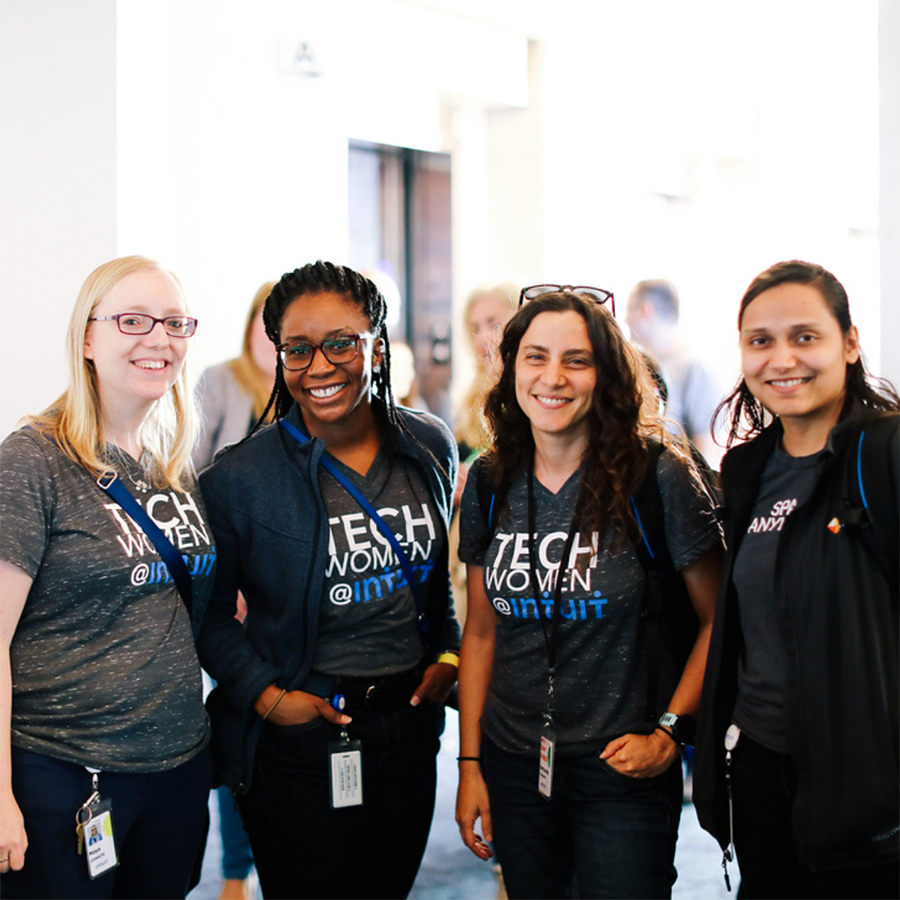
Thanks to all the Tech Women @ Intuit for hosting us warmly at Intuit’s Mountain View headquarters for our Intuit Girl Geek Dinner! Erica Kawamoto Hsu / Girl Geek X
Our mission-aligned Girl Geek X partners are hiring!
- See open jobs at Intuit and check out open jobs at our trusted partner companies.
- Find more Intuit Girl Geek Dinner photos from the event – please tag yourselves!
- Does your company want to sponsor a Girl Geek Dinner in 2021? Talk to us!


